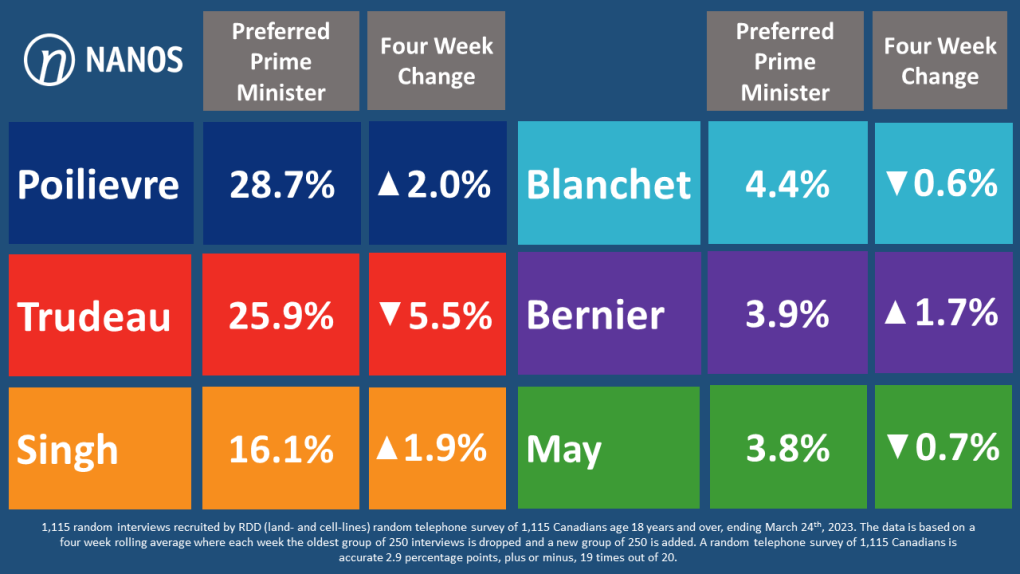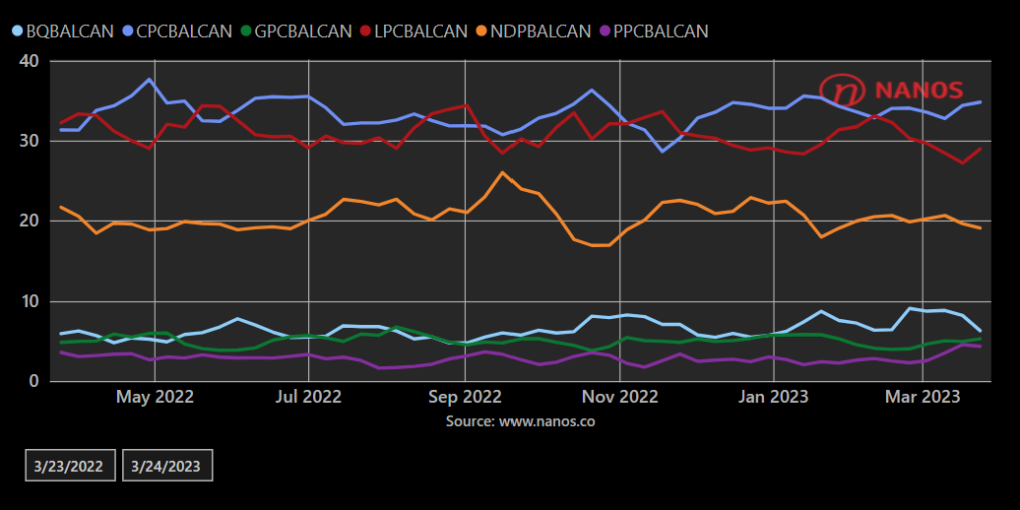The federal Liberals are trending downward on three key measures while Conservative Leader Pierre Poilievre has surpassed Prime Minister Justin Trudeau when it comes to the question of who Canadians would prefer now as their prime minister, according to Nanos Research.
Ballot support has been trending negatively now for weeks for the Liberals, while it's remained steady for the Conservatives; meanwhile, support for Trudeau as prime minister has taken a sharp downward turn as Poilievre's personal numbers have risen to the point of surpassing Trudeau's.
 Preferred Prime Minister (Source: Nanos Research)
Preferred Prime Minister (Source: Nanos Research)
"Usually whoever is the prime minister has some sort of advantage. Right now, Pierre Poilievre outpolls Justin Trudeau," said Nik Nanos, pollster and chair of Nanos Research, on the latest episode of CTV News Trend Line.
LIBERALS LOSING 'ACCESSIBLE VOTERS'
Aside from their sagging numbers on the ballot and preferred prime minister question, the other key metric where the Liberals have fallen behind is on the Nanos power index, which is a composite of measurements including voter preference and leadership impressions, as well accessible voters – the proportion of Canadians who would consider voting for a party.
"Over the course of the last while, the Liberals have consistently had an advantage on the power index and had a stronger brand. Now we see the Conservatives surpassing them for the first time in a couple of years since the last election, when the Conservatives had a little bit of a surge," said Nanos.
Currently, the Conservatives sit at 50 points on the power index, while the Liberals are at 47 and the NDP at 46.
 Power Index (Source: Nanos Research)
Power Index (Source: Nanos Research)
A key reason for the Conservative surge is that their share of accessible voters in Canada is growing.
"For the last … 50 years, the Liberals traditionally have always had a larger pool of accessible voters. That means people that would consider voting Liberal," said Nanos. That was certainly true in the 2015 election when Trudeau secured a majority for the Liberals, who took 184 seats compared with Stephen Harper's Conservatives, who won 99.
"But since 2015, the proportion of Canadians that would consider voting Liberal has gone down. So they've gone from a big tent … to a narrower tent. And as a result, it's impacted the political muscle of the Liberals," said Nanos.
Speaking of elections, Nanos said the good news for the Liberals is that they're not fighting in one anytime soon. With Poilievre's Conservatives currently at 35 per cent on the ballot question, with a six-point lead over the Liberals, they're in the territory they need to be in, in order to win an election.
 Ballot support (Source: Nanos Research)
Ballot support (Source: Nanos Research)
"When Stephen Harper won a number of elections, he won because he had a six-point advantage. Right now, the Conservatives have a six-point advantage," said Nanos.
BUDGET AND BIDEN BOUNCE?
Whether Tuesday's federal budget -- in which the Liberal government prioritized help for Canadians' pocketbooks and promised to invest in a clean economy and fund a national dental care program -- will boost their fortunes in they eyes of voters is yet to be seen. Nanos said wewon't know that for anotherseven to 10 days.
But "it speaks to the importance of the budget and also the most recent visit from President Biden. It's very important for the Liberals to try to reverse this trend right now that currently is favouring Pierre Poilievre and the federal Conservative Party," said Nanos.
Watch the full episode of Trend Line in our video player at the top of this article. You can also listen in our audio player below, or wherever you get your podcasts. The next episode comes out Wednesday, April 12.

Post a Comment